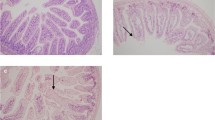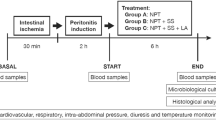Abstract
Pneumoperitoneum (PN) and the gas used to insufflate the abdominal cavity during laparoscopy seem to be responsible for local and systemic modifications. The aim of this study was to verify the effects of intra-abdominal carbon dioxide (CO2) and air insufflation on the peritoneum, as well as the cortico-surrenal response in prepuberal rats. Sixty prepuberal rats were divided into three groups: in the first (S, n = 36), PN was induced with CO2, whereas in the second (A, n = 14), it was induced with filtered room air; in both conditions, insufflation lasted 30 min at a pressure of 10–12 mmHg. The third group (C, n = 10), underwent general anesthesia only. Two hours after inducing anaesthesia, 12 rats in group S, 6 in group A and 6 in group C were killed and the remaining, after 24 h; specimens of the visceral and the parietal peritoneum were obtained for histological examination, blood sample was taken for cortisol and DHEA-S assays at the different study periods. At the histological examination performed 2 h later, the groups S and A presented inflammatory cell infiltrate in the parietal and visceral peritoneum; this finding was even more marked in group A, which presented also congestion, hemorrhage and disruption of the cell line. Twenty-four hours after the experiment, the peritoneum of the two insufflated groups presented chronic infiltrate and reactive mesothelial cells with congestion, which was more evident in group A, but totally absent in group C. Cortisol levels were significantly higher in groups S and A (2.15:1 ratio) killed 2 h later compared to those killed 24 h later and to the control group. DHEA-S levels were not significantly different between the groups. Our results demonstrate that the chemical, physical and molecular impact of CO2 on the peritoneum causes inflammation and tissue damage, this was even more evident 24 h after our experiment and in the air insufflated group. PN induced a significant variation in blood cortisol levels at 2 h. The CO2 insufflation should be limited in patients with pre-existing peritoneal damage.



Similar content being viewed by others
References
Drummond GB, Scott DB (1976) Laparoscopy explosion hazards with nitrous oxide. Br J Med 19:1586
Minoli G, Terruzzi V, Spinzi GC, Benvenuti C, Rossini A (1982) The influence of carbon dioxide and nitrous oxide on pain during laparoscopy: a double-blind, controlled trial. Gastrointest Endosc 28:173–175
Neuhaus SJ, Watson DI, Ellis T, Lafullarde T, Jamieson GG, Russell WJ (2001) Metabolic and immunologic consequences of laparoscopy with helium or carbon dioxide insufflation: a randomized clinical study. ANZ J Surg 71:447–452
Kuntz C, Wunsch A, Bodeker C, Bay F, Rosch R, Windeler J, Herfarth C (2000) Effect of pressure and gas type on intraabdominal, subcutaneous, and blood pH in laparoscopy. Surg Endosc 14:367–371
Sefr R, Puszkailer K, Frana J, Penka I (2001) Effect of carbon dioxide pneumoperitoneum on selected parameters of the acid–base equilibrium in laparoscopic cholecystectomy. Rozhl Chir 80:206–212
Ott DE (2001) Laparoscopy and tribology: the effect of laparoscopic gas on peritoneal fluid. J Am Assoc Gynecol Laparosc 8:117–123
Nagelschmidt M, Gerbecks D, Minor T (2001) The impact of gas laparoscopy on abdominal plasminogen activator activity. Surg Endosc 15:585–588
McHoney M, Corizia L, Eaton S, Kiely EM, Drake DP, Tan HL, Spitz L, Pierro A (2003) Carbon dioxide elimination during laparoscopy in children is age dependent. J Pediatr Surg 38:105–110
Galizia G, Prizio G, Lieto E, Castellano P, Pelosio L, Imperatore V, Ferrara A, Pignatelli C (2001) Hemodynamic and pulmonary changes during open, carbon dioxide pneumoperitoneum and abdominal wall-lifting cholecystectomy. A prospective, randomized study. Surg Endosc 15:477–483
Schafer M, Sagesser H, Reichen J, Krahenbuhl L (2001) Alterations in hemodynamics and hepatic and splanchnic circulation during laparoscopy in rats. Surg Endosc 15:1197–1201
Ho HS, Saunders CJ, Gunther RA, Wolfe BM (1995) Effector of hemodynamics during laparoscopy: CO2 absorption or intra-abdominal pressure? J Surg Res 59:497–503
Tobias JD, Holcomb GW 3rd, Rasmussen GE, Lowe S, Morgan WM 3rd (1996) General anaesthesia using the laryngeal mask airway during brief, laparoscopic inspection of the peritoneum in children. J Laparoendosc Surg 6:175–180
Saad S, Minor I, Mohri T, Nagelschmidt M (2000) The clinical impact of warmed insufflation carbon dioxide gas for laparoscopic cholecystectomy. Surg Endosc 14:787–790
Molinas CR, Koninckx PR (2000) Hypoxaemia induced by CO2 or helium pneumoperitoneum is a co-factor in adhesion formation in rabbits. Hum Reprod 15:1758–1763
Luo K, Li JS, Li LT, Wang KH, Shun JM (2003) Operative stress response and energy metabolism after laparoscopic cholecystectomy compared to open surgery. World J Gastroenterol 9:847–850
Aitola P, Airo I, Kaukinen S, Ylitalo P (1998) Comparison of N2O and CO2 pneumoperitoneum during laparoscopic cholecystectomy with special reference to postoperative pain. Surg Laparosc Endosc 8:140–144
Author information
Authors and Affiliations
Corresponding author
Rights and permissions
About this article
Cite this article
Papparella, A., Noviello, C., Romano, M. et al. Local and systemic impact of pnemoperitoneum on prepuberal rats. Pediatr Surg Int 23, 453–457 (2007). https://doi.org/10.1007/s00383-006-1860-z
Published:
Issue Date:
DOI: https://doi.org/10.1007/s00383-006-1860-z




